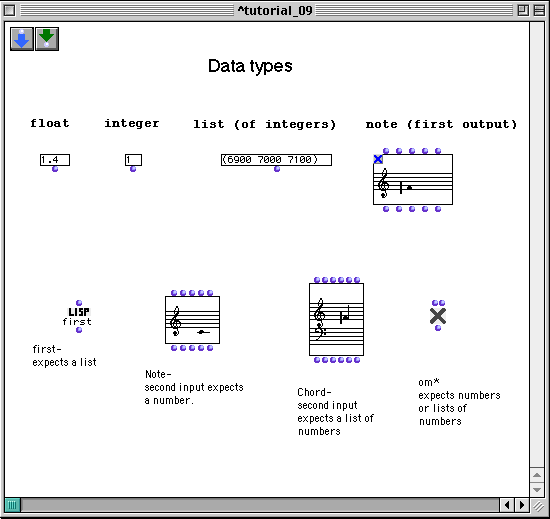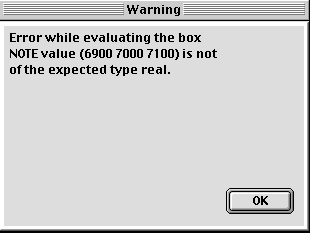OpenMusic Tutorials
Prev| Chapter 1. Using Musical Objects I| Next
Tutorial 9: Dealing with data types
Topics
Introduces the concept of data type.
Key Modules Used
The Concept:
This postlude will demonstrate what is meant by data type.
The Patch:

In LISP, inputs to functions and classes are typed, which is to say they
expect a certain kind of data. To see what we mean, bring up the online
documentation for the Note object by selecting it and hitting
d. The inputs are listed, and we see that the second, _midic_ , expects
a number.
Now, drag a connection from the list of integers to this second input of Note and evaluate. You’ll get an error like this:

This is because a list is a different data type than a real. real is LISP’s term for any kind of number.
first, on the other hand, only accepts lists as input, since
it takes the first element of a list. Give the float to first
as input and you’ll get a similar error. float is LISP’s term for a number
with decimals.
Now, plug the list of integers into first.
first has what it wants; evaluating gives the answer 6900. You
can take this 6900 at the output of first and plug it into the
second input _midic_ of the Note object. It too, now has
what it wants. You can find out the data types accepted by any function by
looking it up in theFunction Reference.
Take the list of integers and plug it into the second input _lmidic_ of the
Chord object. This input expects a list, and you’ll see the
notes in the mini-view.
Now, take the first output of the top Note object, _self_.
_self_ exists for many classes, and outputs the entire object. Evaluate self
and you’ll see something like #<note #x9327B36> in the Listener. This is the
Note object, and it is a data type like list and float. Plug
this into the first input of the lower Note object.
Evaluating effectively duplicates the Note because it passes
itself to the _self_ input of the other note.
Plug the _self_ output of the Note into one of the inputs
of om*. Error. This is because the Note
object is not just a midic- it’s the collection of attributes of that
Note, including volume, duration, and MIDI channel. The
_self_ output of the Note contains all the information from
the other inputs. As seen earlier, if you want to take just the midic of the
Note, you must take it from the _midic_ output. Do this now
and plug it into om*. At the second input you may use
either a integer or a list or a float. None of these cause errors. Why not?
OM functions are what is called a generic or polymorphic function. This means that they can be programmed to perfom differently depending on the data type they are given as input. This will be discussed in more detail later.
Now take the _self_ output of the Note object and plug it
into the _self_ input of the Chord object. The note
appears in the Chord. What gives?
You’ve just witnessed a concept called inheritance. Inheritance will be explained in more detail later, but for now, you should know that all classes in LISP, but particularly the music objects, can ‘inherit’ information from simpler objects. A Chord is collection of Notes; it can therefore inherit from the Note class.
Play around with the functions and objects in this patch to get your mind around the concept of data type.
Prev| Home| Next
—|—|—
Tutorial 8: Construction of a harmonic series| Up| Playing
MIDI I